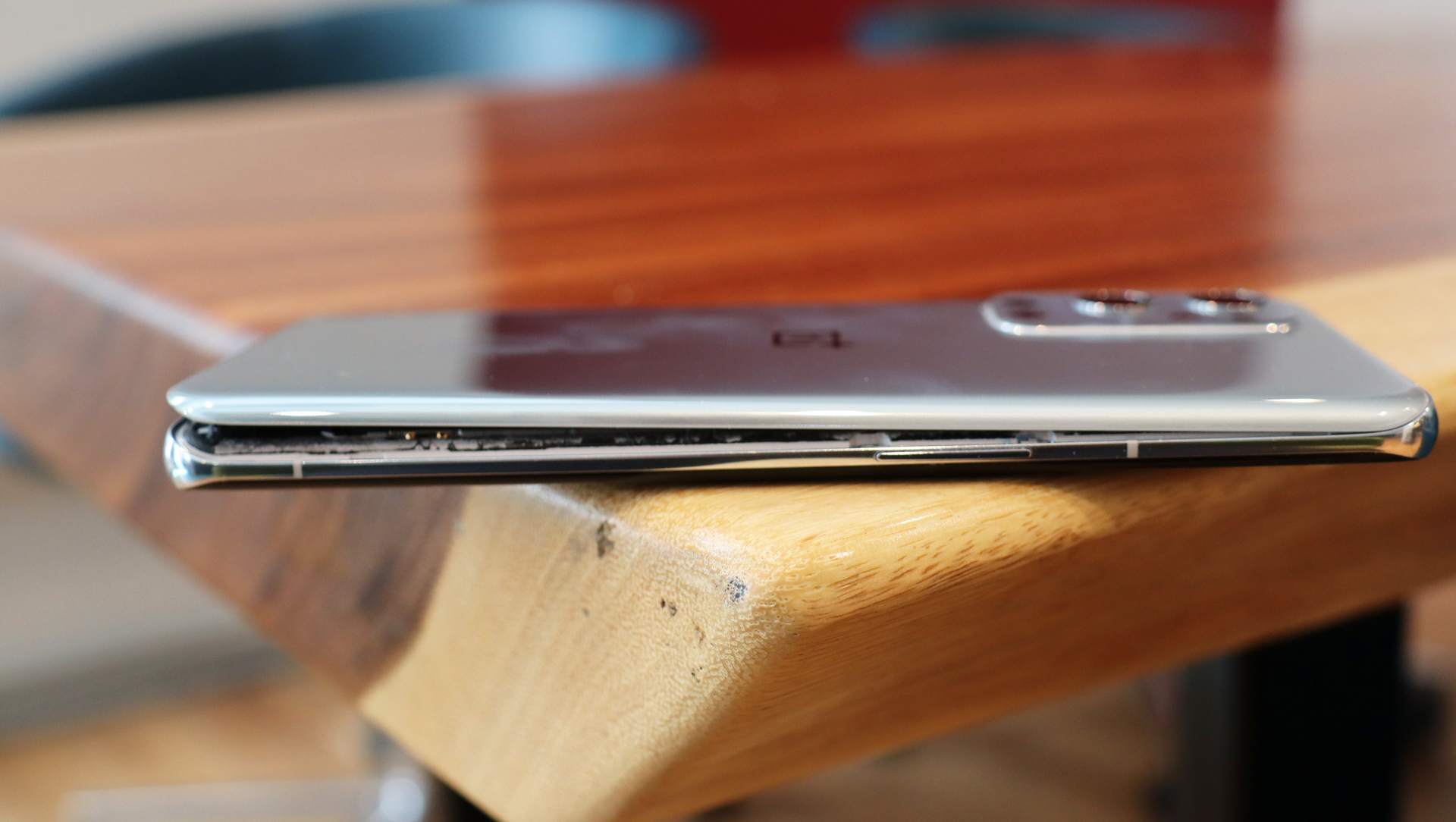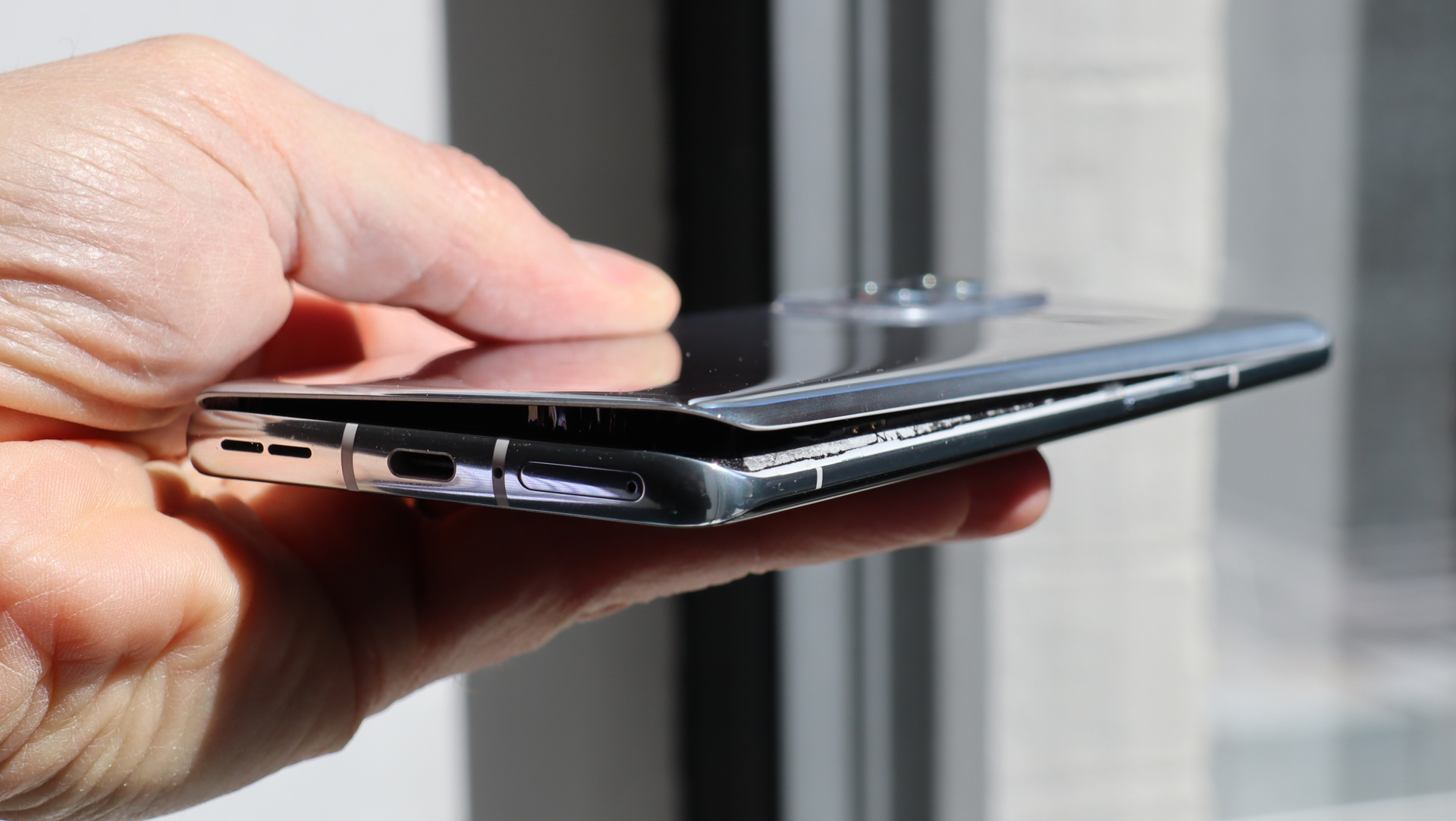My OnePlus 9 Pro battery is so swollen it split open the case.
I discovered this potentially dangerous situation by accident when I noticed the one-year-old Android phone sitting imperfectly in its carbon-fiber case. Absentmindedly, I reached over and pushed one corner of the phone down, trying to reseat it. It popped back out. After a few attempts, I removed the case and discovered the truth: The battery had expanded and split the chrome case along one long-glued seam, creating, in one area, a quarter-inch chasm.
"Not again," I thought.
A few years ago, a Google Pixel 3 XL that I mostly keep on a Pixel charging stand by my bed appeared to jump off the charger of its own accord. It turned out that the battery has expanded so much that the case no longer sat flush with the charging base.
I eventually sent the phone back to Google and got a replacement; at least that phone was more than a few years old. But I reviewed the OnePlus 9 Pro just over a year ago. At the time, I called it "a gorgeous device," and "one of the best devices I've used in the Android space." Even with the split back, it still looks pretty good.
Does it still work? Sure. I powered it up and it launched, like Head Wound Harry, as if there wasn't any critical damage.
Still, I won't use it now or ever again.
As soon as I posted a short video of the split phone on Twitter, I got a fast flood of responses and at least one warning: "I'd, uh, turn it off."
This is concerning. OnePlus 9Pro 5G battery is now bursting the phone’s seams. Not the first time I’ve seen an Android phone do this pic.twitter.com/5HfdokTXG5March 28, 2022
I also found a community of people who have suffered similar battery calamities on a variety of Android phones and iPhones. I've owned and tested every iPhone since the iPhone 4 and never had a battery balloon or case split.
Still the tales of puffy batteries traveled through numerous Samsung handsets, iPhones, MacBooks, and Pixels.
On Reddit and support pages for OnePlus and Google, I found more evidence.
It's a big enough problem that there are FAQs and services devoted to it. I found a place called Bebat that tries to explain why cellphone Lithium-Ion batteries balloon and what to do about it. Yes, it's also selling a repair service.
No one, including Bebat, is certain why all these batteries occasionally puff up. It could be:
- Overheating
- Overuse
- Too much charging
- A defective part
It's almost like no one quite understands how these batteries work. Though we know they do - most of the time.
An expanding phone battery and concerns over what could happen next if I keep using or charging it (explosion and fire come to mind) take me back seven or so years to Samsung's Galaxy Note 7.
The Galaxy Note 7 was an Android industry darling right up until units began to explode and catch fire. The culprit was the lithium-Ion battery.
Before you can understand what goes wrong with such a power source, it helps to understand how most Lithium-Ion batteries work. It's something we all got a crash course in back in 2016.

Like most batteries, there's a positive and negative side, usually made of two different conductive materials (say, aluminum and graphite). Since a battery creates power through chemistry and flow of charged ions, there's also a liquid (called an electrolyte), and a thin plastic layer made to separate the positive and negative sides. The cells charge when we plug the phone in.
Unlike the batteries in, say, your remote control, phone batteries can't be round and thick, nor can everything sit neatly in just two layers. Usually, smartphone batteries fold the layers over and over, sandwiching them to make them thin and as flat (and store as much energy) as possible.
As you can imagine, if all this isn't done perfectly, something can go wrong. In Samsung's case, it was a huge battery being squished into too small a space, deforming some layers, as well as a production issue in which a bad weld perforated these layers in some devices.

Samsung learned its lesson and instituted some rigorous battery oversight and testing for all future devices. There has not been a notable incidence since.
Which is good. But why are our phone batteries still expanding?
Since this issues cuts across devices, it's clearly some intrinsic lithium-ion issue.
Even experts like Bebat don't offer any clear-cut idea of why or what companies could do to prevent this. They do know what you can't do though:
There is no point waiting for the battery to “shrink”. The ever growing pressure can cause damage to the entire device. Leave the battery in the device only if it is stuck. Never try to “solve” the swelling yourself by pricking a hole in it or with any other creative stunt. That is very dangerous: not only is the gas flammable, but also toxic.
In every support forum, the advice is the same. Stop using the device immediately and get it to a service center. One MacBook user claimed to me on Twitter that an Apple Store genius told him to give the laptop to them and "we can put it in back in the special safe in case it explodes."
That sounds dramatic, but an exploding Lithium-ion battery is not out of the realm of possibility.
I don't think I'm in any imminent danger here, but I have turned off the OnePlus 9 Pro and reached out to the company's representatives for comment. My more immediate concern is that, while hardly common, I'm not sure expanding, gas-filled batteries are uncommon.
Making these incidents public is the first step, I hope, in pushing phone manufacturers to be more transparent, to work on safer, less expansion-prone batteries, and to look for a less volatile power storage system than lithium-ion. It's a tall order, I know.
Now, where do I store this scary OnePlus 9 Pro?
from TechRadar - All the latest technology news https://ift.tt/tc4yrXz




0 Comments